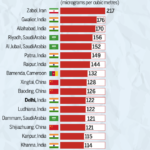INTER-GOVERNMENTAL AGREEMENT BETWEEN INDIA AND MAURITIUS ON COOPERATION IN COOPERATIVES AND RELATED FIELDS

The Union Cabinet has given its approval for signing of an Inter-Governmental Agreement between India and Mauritius on cooperation in cooperatives and related fields.
The Agreement between the two countries will be for duration of five years after which it will be automatically extended for another five years. The Agreement provides for promoting cooperation through short and medium term programmes within the framework of the joint activities mentioned in the Agreement. A work plan will be drawn up by mutual Agreement between the two parties to give effect to the objectives of this Agreement.
Background:
The Government of Mauritius has shown keen Interest to develop Institutional Mechanism between Cooperative Development Fund (CDF) set up by it and National Cooperative Union of India (NCUI) so as to benefit from NCUI’s experience in Cooperative Development. A joint meeting was held in September, 2012 in Department of Agriculture, Cooperation & Farmers Welfare followed by Ministerial level meeting after a year (in September, 2013) for discussing the possibility of signing an MoU between the two countries for exchange of legislation governing cooperatives, exchange of information and technicalities pertaining to the cooperative sector, establishment of institutional linkages and deputation of experts under ITEC programme. A delegation of two senior officials from the Mauritius Government visited cooperative organisations of India to explore the possibilities of bilateral cooperation in the field of cooperatives.
CROSS REFRENCES
Mauritius, island nation in the Indian Ocean, is known for its beaches, lagoons and reefs. The capital city of Mauritius is Port Louis.
LAGOON: A body of water cut off from the open sea by coral reefs or sand bars
CORAL REEFS
A reef composed mainly composed of living coral, coral skeleton and calcium carbonate deposits from other organisms such as calcareous algae, mollusks and protozoans. It is made chiefly of compacted coral together with algal material and bio chemically deposited magnesium and calcium carbonates.
Most coral reefs form in warm, shallow sea waters and rise to or near the surface, generally in the form of a barrier reef, fringing reef,or atoll. The Great Barrier Reef off thenortheastern coast of Australia extends for some 2,000 km (1,240 mi),making it the world’s largest coral reef.
In reality, a coral is a simple animal like the sea anemone we find on rocky beaches. Unlike the anemone, the coral animal is generally small and constructs a skeleton around its body for protection. A coral animal is also called a polyp. The external surface of the polyp has some special cells called calicoblasts that can take dissolved calcium from seawater and construct a solid skeleton.
Corals feed on tiny microscopic animals called plankton. The reef building corals require warm temperatures for their survival. They grow well at temperatures greater than 20°C and can thrive even at 35°C as in the Red Sea, Persian Gulf or our Gulf of Kachchh. Some of them occur sometimes at low temperatures, even down to 10°C, but they do not form reefs. It is because of this preference for warm waters, that the greatest number of corals is found in the tropical belt, with a decrease towards the subtropical seas.
Reef building begins in a very simple way. The coral larva settling on a hard substratum begins to grow into one colony by repeated budding. This colony continues to grow vertically towards the sea surface and laterally as far as they can. Besides corals, several other organisms in the reef, notably the mollusks and some algae, called calcareous algae, also construct calcium skeletons. When these organisms die, the calcium first dissolves and then re-solidifies to form a rock, on which new corals come and settle. Thus between every birth and death scenario, the reef continues to grow. On an average a reef grows by 1 mm per year.
The reefs are formed: at the beginning, the corals settle and grow near the coastline, often growing almost up to the edge of the shore (high water level). At this stage they are called fringing reefs because they border on the land.
As the corals can now grow only seaward, they start propagating in that direction. In the process, they create a gap between the shoreline and reef. This space, generally with less number of coral colonies, becomes the lagoon. At this stage of its evolution, the reef is called a barrier reef.
If the corals happen to be growing around an island and if the island happened to sink below the sea surface, then the reef structure would resemble a ring around the non-existing island. The place once occupied by the island becomes the lagoon and the reef is then called an atoll.
Fringing reefs are common. They occur around the islands in the Gulf of Mannar, Gulf of Kachchh, Andaman and Nicobar Islands. The reefs in the Lakshadweep group of islands are oceanic atolls.






0 Comments